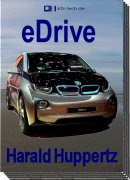
eDrive - Comparison (Model 3)

Quite honestly, the ventilation setting is quite well solved, but this is certainly only a limited time a unique point for Tesla and of course for a vehicle with combustion engine also possible. But that's what it's all about. We
want to explore on a model 3 of Tesla how many similarities still exist between a pure electric car and one with internal combustion engine.
Of course, the vehicle can have two complete drives, but there was something like that with combustion engine cars too, even in series production. Let's start with the wheels, they're the same of course. The
aerodynamic hubcaps are also possible for both drive types. Completely identical is the brake system with four-piston fixed and single-piston floating caliper, the front ones ventilated.
When considering the chassis alone, there are no differences even in the version with air suspension. Of course, the steering and braking servos must be forced electrically, but as soon as the combustion engine
offers the possibility of sailing, it also has this, including perhaps an electric air-conditioning compressor.
It is only the cooling system that goes well beyond the level of a mid-range passenger car in terms of effort, because there are many more components to be supplied, and the battery is only mentioned here as an
example. Accordingly, the front looks more like a mid-engine sports car, even though it appears to be closed. There are controllable flaps for the cooling air inlet and a comparatively large fan. And of course such a
sports car a la Corvette 2020 also has a small front luggage compartment.
At first sight the spread of the aluminum part in the Model 3 might be confusing. In the front there is a removable chassis frame with an additional cross member, all made of aluminium and with a not to serious
accident easily replaceable. This is not the case at the rear. Here, the steel outer skin and aluminium structure come relatively close to each other on the inside.
It's obvious that something like this has to be well isolated from each other. Unfortunately, the inner wheel arch is not bolted, which would make repairs much easier. In the front the fenders even have a inner structure,
which always made it difficult to repair light damage to hoods at low cost. Quite unusual in the automotive sector, but, if necessary, by no means only in the case of E-Cars doable.
The Model 3 is almost more than solidly built. The passenger structure is largely made of steel, but in addition, the large dimens sills have extremely strong longitudinal beams of Aluminium built-in. So the car is quite
well equipped for accident situations, especially since, unlike the Model y, it has a solid cross beam between the B-pillars despite the panorama roof.
So far we haven't really found many differences. Well, pure rear engines have always been very rare in this class of internal combustion limousines. But if you look at the rear wheel drive of the Tesla, then one finds even
an oil filter. Well, it's for transmission oil, but it certainly has to be replaced with its oil at some point. And recently yes, especially for automatic transmissions, rinsing is recommended everywhere.
At this point it is once again clearly doubted whether an e-car actually has such much lower maintenance costs if the equipment is so similar. After all, a combustion engine can rekuperate, too, and thus spare his
brakes. When ordering a new vehicle, a certain amount of E-equipment makes sense in any case.
Where the comparison really goes wrong is with the weight, which really lands with the Model 3 including driver with a hundredweight under 2 tons. Of course, a 4.7 m long model is not that heavy, sedans with
combustion engine, also not with all-wheel drive. Even a balanced weight distribution is of no use here, because you could theoretically achieve this on the comparison car by using corresponding built-in additional
weights.
Surprisingly, the Tesla is not only blamed for this serious disadvantage because of the batteries. There is also criticism of the body, which is described as much too stiff and too heavy. Basically it is said that a large
series producer, like presumably VW, can produce such a car with less weight, with much less effort and therefore much cheaper.
At the end there remains a highlight of the Model 3, beside the battery. That is the engine. The rear one in particular is meant here, which differs fundamentally from the front one (picture above). A further reason to order
the version with rear engine exclusively. It is a reluctance engine, sufficiently praised in this book.
Perhaps, in addition to its more than sufficient track ability, just where you need it, this is one reason why, despite the enormous mass of the vehicle, it should be able to get around at least in moderate summer with a
reasonable 130 km/h and fabulous 2 liter Diesel equivalent can move across the highway.
|